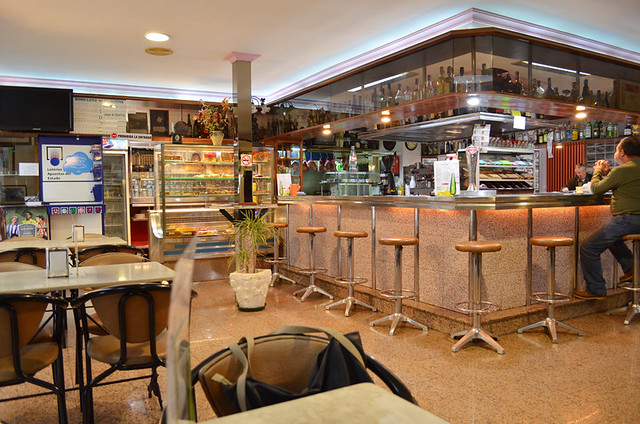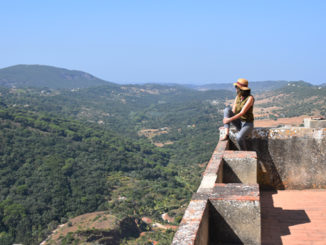“But do you want authentic travel experiences, do you really?”
Sometimes in my head I hear Josh Thomas from the excellent Australian TV series Please Like Me asking travellers this question in his inimitable manner.

Slovenia 2019
It’s a rural station, only a handful of trains pass through it daily. Figuring out which is the one we want can’t be that difficult, can it? The timetable is simple enough to understand. Two trains will pull into the station at almost the same time, both going in opposite directions. One will be ours, one won’t. There are no TV screens, no staff, and no signs on any of the numerous ground-level platforms between the station building and a sawmill opposite. To complicate matters there’s another train (not listed in the timetable) already in the station; a car train with a single passenger carriage. A one-legged cyclist is hoisting his bike into the carriage. Andy asks him if it’s the train for Nova Gorica. He nods it is. But I need confirmation from a reputable source. As the time for the trains to arrive (and depart) draws close, the stationmaster appears on the platform. I ask if the one-carriage train is the one we want. It isn’t. He informs me our train will be the one arriving at platform 4. I thank him and rush back to Andy to tell her to grab her bag, we’re on the wrong platform.
She hits me with a question which floors me.
“Which one is platform 4?”
None of the platforms are numbered.

Authentic travel?
How do we define authentic travel anyway? It’s a question I ponder every now and again, especially in this era where everything and everyone has to be labelled. I try to fight it, but I mentally carry a pad of yellow post-it stickers which I stick to people’s heads far too quickly. Brexit is responsible for the one I use most whenever I encounter other Brits. But I really do try to avoid blatantly manufactured labels. They’re usually somebody’s attempt to manipulate us for gain of some sort – financial, political… or for some other motive.

Thailand in a previous century
A mag in our hotel room recommends a restaurant off the Phahonyothin Road. We jump in a taxi and, nearly an hour later, are dropped off in a dark side street who knows where. We didn’t know the road ran all the way from Bangkok to Myanmar. There is, thankfully, a restaurant, and an attractively rustic one at that – all bamboo panels and palm leaves. A trio of musicians sitting in a rowing boat play the Thai version of Cajun music. We are the only non-Thais in the busy restaurant and the waiting staff don’t speak English. An English-speaking student with a big smile intervenes when she spots we’re struggling. We order snakehead fish, ant salad, sticky rice, and a magnum-sized bottle of Singha beer. When the band finish a song we clap enthusiastically, but nobody else does. Every head in the restaurant turns in our direction. From then the trio of musicians, and other diners, look in our direction expectantly at the end of every number. I take another cultural misstep at the end of the meal when my sign language attempt to ask for the bill is mistaken for a request to pay for a night with the waitress. The English-speaking student clears the misunderstanding up. We leave the restaurant and return to the pitch black street. Now there’s just the little problem of finding a taxi.

Today’s new word is…
Buzz phrases are created constantly. Yesterday alone I learned a raft of labels I hadn’t heard before; second-city travel; slo-mo; undertourism; all-amusive. Some had the hallmarks of PR speak, others had travel writers’ pitch stamped all over them; flies on a fishing hook intended to reel in editors. Most were designed to make people feel good about how they travel. Some especially grated because there’s already a perfectly good term that captures the essence of taking time to appreciate places, and that’s Slow Travel.

El Hierro 2016
We’re the only diners in the village’s bar/restaurant. The lighting is bright and harsh, the décor basic; we’ve eaten in numerous tascas which look just like this. There are three other patrons, all weary-looking men hunched over the wooden bar, their arms encircling the drinks in front of them like protective harbour walls – possibly to prevent the gale-force wind gusting through the open front door from blowing the drinks over. Despite being inside we’re cold. We sit, still wearing light coats that simply aren’t robust enough to keep us anything like remotely warm, huddled over plates of parrot fish. The reason for the open door on a nippy winter night is the owner of the bar is smoking. Spanish law dictates he can’t do that inside the bar, so he has parked his stool right at the entrance. His body is inside the bar, but the arm holding the cigarette is held outside.
The waitress brings us a bottle of wine. It tastes like vinegar.
“The wine’s corked,” Andy tells her.
She doesn’t drink wine but says she’ll ask one of the other customers to see what they think. She fills a glass and hands it to one of the men at the bar. He declares it to taste fine. I suspect if she’d handed him a glass of bleach the answer would have been no different.

Which traveller?
Transient trendy terms aside, there are differences in what we all want from our travels. Some crave authenticity; others want a blend of experiences; and there are those who aren’t interested in authenticity at all. Then there are the sub-groups. All of which is why applying generic labels is risky. Over the years I’ve come to realise trying to second guess what people want (expect) from what they perceive to be authentic travel is a complicated business. On our travels the experiences which have felt most authentic have often been raw, unfamiliar, and even uncomfortable to a point (sometimes literally as well as figuratively) as they’re often way outside the comfort zone.

Portugal 2018
The restaurant is huge, as though designed to cater for large excursion groups. Except, despite being filled to almost capacity, you won’t find any tour groups in this place. The bulk of the diners are fish and seafood-loving locals. It is incredibly noisy; rambunctuous chatter buzzes around the ears. To communicate with our friends we have to shout across the table, helping raise decibel levels even higher. It’s a Marmite dining experience. Some visitors will love the joie de vivre and embrace the lively local gastronomic scene, especially as the seafood it serves which draws the crowds is delicious and generous. Others will hate it. It simply won’t fit their image of what authentic dining should be – it’s not quaint, quiet, or in a picturesque location. To make matters worse, the foursome at the next table are chain smokers. Yes, we’re inside and no, people shouldn’t be smoking. But there seems to be a legal loophole. The floor to ceiling windows in the room we’re in can be slid open if required, making it more of an outdoor terrace. It’s not really inside… even though it really is.

Acceptable authenticity
There’s a sub-section of travellers who think/say they want authenticity, but actually what they’re hoping for is the version they feel most comfortable with; the one which matches their vision of what authenticity should be rather than what it actually is. There’s nothing wrong with that, unless they start complaining when they encounter true authenticity. But, because of this desire to find a bespoke travel Nirvana to suit, they can be among the most difficult travellers of all to please.
These are the ones which would have Josh asking “But do you want authentic travel experiences, do you really?”




Be the first to comment